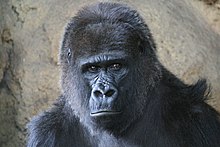Ueno Zoo
[4] The ground was originally estate of the imperial family, but was bestowed (恩賜, onshi, forming the first part of the name in Japanese, untranslated officially) to the municipal government in 1924 — along with Ueno Park — on the occasion of crown prince Hirohito's wedding.
[6] Shortly after the March 1945 bombings of Tokyo, the Japanese placed U.S. Army Air Force navigator and bombardier Ray "Hap" Halloran on display naked in a Ueno Zoo tiger cage, as Halloran later recalled "'the hated B-29 prisoner', naked, unwashed and covered with sores from fleas, lice and bed bug bites", so civilians could walk in front of the cage and view him.
In recent years, some of the old-fashioned cages of the past have been replaced with modern habitats, such as the "Gorilla Woods," built after two well-publicized mishaps in 1999.
The male panda, Billy (比力 ビーリー) was renamed in Ueno to Līlī (力力 リーリー) to emphasize his playful vitality.
The female's name Siennyu (仙女 シィエンニュ ‘Fairy’) was changed to Shinshin (真真 シンシン), referring to purity (純真) and innocence (天真).
The western garden houses red pandas, western grey kangaroos, African penguins, Caribbean flamingos, shoebills, Barbary sheep] hippopotamus, pygmy hippopotamus, black rhinoceros, reticulated giraffes, okapis, Aldabra giant tortoises, saltwater crocodiles, green iguanas, Japanese pond turtles, aye-ayes, ring-tailed lemurs, black-and-white ruffed lemurs, eastern lesser bamboo lemur, cackling geese, great white pelicans, Oriental storks and Steller's sea eagles.




